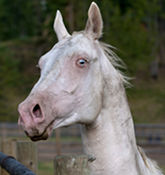
Image from Kerri-Jo
There is a great deal of debate in the horse world surrounding albino horses. From everything I’ve read & everyone I’ve talked to it seems evident that albinism does not exist in the equine world.
It’s A Common Misconception
Generally what people think is albino is actually a double dose of the cream dilution gene which dilutes the coat to a shiny white color with light skin and light, clear eyes. However that’s not the only white horse type that can cause mistaken identity.
There is a surprising list of genetic types which may produce an animal that can be mistaken for an albino. They are listed below from the most likely suspect to least.
3 Creamy Shades
There are three shades that come from a double cream gene – all of which can cause pink skin & light colored eyes.
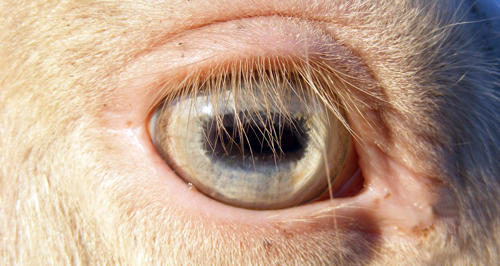
Cremello – Double cream on a chestnut animal & perhaps the most likely to be mistaken for albino.
Perlino – Double cream on a bay animal – often their mane & tail is slightly reddish in color.
Smoky Cream – Double cream on a black animal – are generally a creamier white in color.
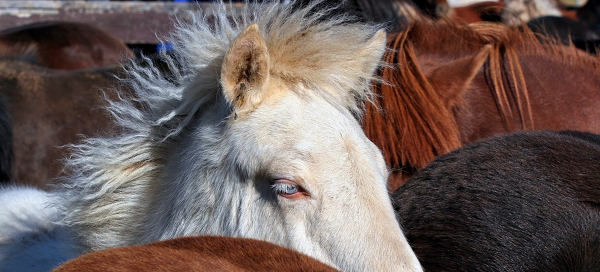
Pinto Patterns
Several of the pinto white patterns can create a totally white animal with light skin and blue eyes.
Extreme Sabino – This is a pinto pattern that when extreme can create a white animal. However they generally retain a bit of coloring somewhere along their topline.
Extreme Splash White – This is a pinto pattern that starts from the bottom up – like the horse was dipped feet first in white paint. In extreme form it can create a totally white animal. The color, if any stays along the topline.
Occasionally Extreme Overos & Tobianos – Both of these patterns can be expressed in a white animal, however it happens less frequently than with the two patterns above.
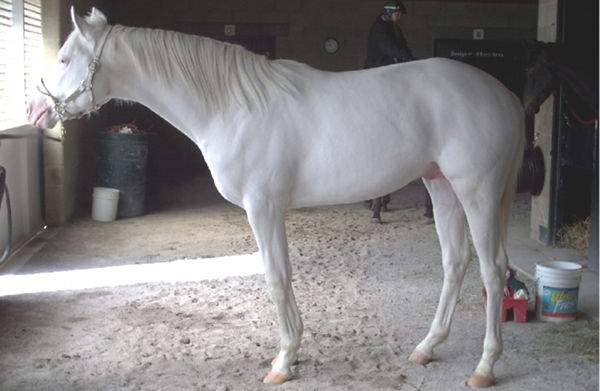
Dominant White
The genetics behind color are not straightforward & the dominant white gene is one I don’t understand. However I do know that it is controversial and requires someone with more knowledge than myself to explain it. (See the bottom of the post for some resources).
Grey
The grey modifier affects all coat colors and intensifies as the animal ages. They are generally born dark and slowly ‘grey out’ with age – however their eyes and skin will remain dark.
Few Spot Leopard
The appaloosa white pattern is often less white than the base color, however when maximally expressed the animal can be left with little or no color. These animals will generally still display mottled skin & other appaloosa traits.
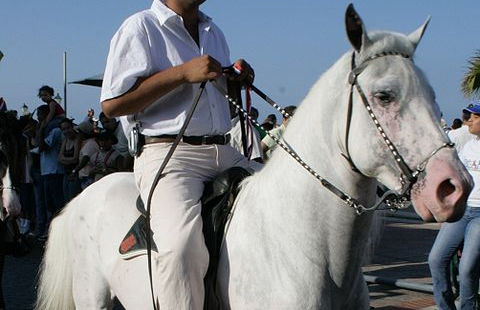
Lethal White Overo
This is perhaps also often mistaken for albinism, (but I’ve added it at the bottom because no adult horses carry it). Again it’s too complicated for me to explain here but it is fatal. This gene affects digestive system development & the foal does not generally survive more than 72 hours. Animals may be tested for probability of throwing a lethal white and careful breeding practices must be followed when breeding for the Frame Overo white patterns to avoid it.
What’s Your Theory?
It’s easy to see how people can be mistaken about albino animals, there are 6 or 7 different types of dilutions or patterns that can create an animal that looks albino.
Here are a few credible places to learn more in-depth information.

I hate Lethal White Overo! it happens when you breed an overo to an overo and when the foal is born it doesn’t have a complete digestive tract…
So whats an Albino?
An albino horse does not exist – the whites mentioned above are just the most often mistaken for them.
I have a perlino and most people think she is albino, we have bred her to a palomino, and a sorrel and both times she has had a buckskin filly, one very dark and the other buttermilk with dark brown points, her mane and tail have alot of gray in them.
I own a palomino stallion and have bred palomino mares and buckskin mares and very rarely have had creamello or Perlino, in fact only one of each so far.
I have an extreme sabino and I do get asked if he’s albino. His eyes are dark brown not blue. His skin is pink with a mottled black sabino pattern on the skin around his face neck and shoulders. His coat is bright white and he has a small amount of chestnut colour inside his ears and through his tail. When he’s wet his coat goes transparent and all of the pigmented skin is visible. I haven’t seen any other horses around in this colour except in photos.
Here’s a link to a photo of me and my horse Archie.
http://macarcher.blogspot.com/2010/09/welcome-to-my-blog.html
Vicki